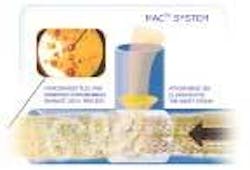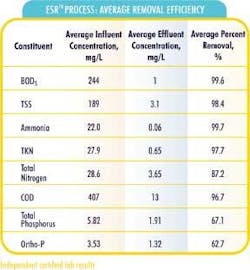Treatment System Reduces Sludge Production
By Ken Norcross
Wastewater treatment plants are suffering from the sludge/tail wagging the plant/dog to an ever more disturbing affect. Environmental regulations for sludge disposal are becoming more stringent and landfill costs are escalating at an alarming rate.
One obvious answer to these challenges is to find a way to reduce sludge production. The problem is that traditionally the sludge production rate is a given, largely unaffected by the process or the process equipment. But this appears to be changing. Results from five years of testing on a new treatment technology show that it can reduce the real total cost of wastewater treatment and address the serious problem of sludge processing and disposal.
Premier Wastewater International (PWI) has developed an innovative yet simple proprietary wastewater treatment process that can reduce organic sludge production by as much as 90%. The Enhanced Solids Reduction (ESR) process is an advanced activated sludge treatment system that has been designed to condition the entire waste stream, resulting in reduction of organic matter.
At the heart of the ESR system is the Multi-Action Conditioner (MAC) system that combines aeration with thorough blending of the wastewater and activated sludge. This is accomplished by violently mixing atmospheric air and mixed liquor under pressure, creating a toroidal vortex and cavitation action that fractionalizes the solids.
The system shears the air into microbubbles and delivers it in close proximity to the microorganisms and nutrients. The mixed liquor is blended into a uniform consistency. The result is a high decay coefficient and reduced sludge production.
PWI has been testing the MAC system and ESR process in both municipal and industrial applications for over five years. For the past three years the company has operated a demonstration plant in Mesquite, NV. The first test involved treating as much as 100,000 gpd of municipal wastewater and providing reuse quality effluent that would meet California's stringent Rule-22 discharge requirements.
The demonstration plant consisted of two aeration tanks with a working capacity of 5,800 gallons each. An anoxic tank was used for denitrification. Coarse bar screening, clarification, a sand filter and chlorine disinfection completed the plant design. Solids from the clarifiers and the filter backwash water were returned to the ESR tanks for further processing.
In the first 10 months of operation, the plant processed over 15 million gallons (50,000 gpd average). During that time, Title 22 effluent was met and no sludge was wasted. Net sludge yield was calculated at less than 0.1 gTSS/gBODr, compared to the typical value of 0.8 g/g. Average effluent TKN levels were reduced to less than 1.0 mg/L.
Certified test results reflect that the ESR process is also an effective nitrogen removal process (low levels of effluent phosphorus would require simple addition of alum or ferric).
The ESR process does not require any chemical additives such as flocculants, oxidants, manufactured microorganisms, or enzymes. During this test, the Mean-Cell Residence Time (MCRT) averaged well over 80 days. The low net sludge production and long MCRT indicates a nearly complete volatilization of the organic matter.
The loading range for this test (food-to-microorganism (F/M) ratio) averaged 0.1 to 0.65, indicating a conventional to high rate process loading range. The Dissolved Oxygen (DO) levels ranged from between 1.5 mg/L to 3.5 mg/L. Testing also indicated that the plant would operate best with a Mixed Liquor Suspended Solids (MLSS) concentration ranging from 2,000 mg/L to 4000 mg/L, although it has worked well with MLSS levels exceeding 5,000 mg/L.
A subsequent test involved doing a side-by-side comparison between the ESR system and traditional aeration. The wastewater was pulled from an EQ tank in equal flows and sent to identical treatment trains consisting of an aeration basin, a clarifier and a sand filter. The solids captured in the clarifier and filter were returned to the aeration basin.
The only difference in the two trains was that one aeration tank used a traditional blower with course air diffusers and the other aeration tank used a MAC system. Both trains started with identical activated sludge and a Mixed Liquor Suspended Solids (MLSS) level of about 2,200 mg/L. A DO level of at least 2 ppm was maintained at all times. After 30 days the MLSS in the train with the blower had risen to 4,500 mg/L or an increase of 105%. The MLSS in the train with the MAC system was less than 2,500mg/L or an increase of 14%.
ESR Process Characteristics
The extensive testing has demonstrated that the ESR process is readily scaleable and provides process flexibility. The system can assume any of the traditional configurations for activated sludge processes including complete mix, plug flow, contact stabilization, step feed, SBR and extended aeration.
With no moving parts in the basin, the ESR process is ideal for retrofit into an existing facility. In a new plant design the primary settlers can be eliminated. The entire waste stream flows from the headworks directly into the ESR tank. If required, anoxic zones can be added for denitrification. Depending on discharge requirements, the effluent can be sent through filters and/or a disinfection process similar to traditional systems. Because of its simplicity, installation does not normally impact current operation and can be done quickly.
As water conservation is becoming an important environmental and financial issue throughout the world, the ability to provide high quality reuse water is another problem municipalities, developers and plant managers are facing. The ERS process has proven to be an attractive option to meet this demand. Because of the low sludge production, small footprint, low construction and operating costs, minimal odors and other benefits, it is ideal for use as a satellite or stand-alone solution to providing quality reuse water.
The ESR process also provides other benefits compared to traditional plants. As oxygen is immediately added to the waste stream, the process significantly reduces odors. Also, as the need for primary clarification, sludge processing and other equipment is either reduced or eliminated, the ESR footprint is 25% to 50% smaller than traditional treatment plants. In addition, because of the reduction in odors and misting plus the elimination of blowers, the neighbors and plant workers are happier.
The simplicity of the ESR process means that capital costs are reduced 20% to 40%. When installed in existing treatment facilities that are experiencing demand beyond their capacity, this process can increase capacity and reduce sludge production without requiring a major and costly expansion.
Testing is currently being conducted using the ESR process in small flow applications as well. PWI has been successfully operating a 500 gpd test for over a year and recently installed two small flow systems, one in Arizona with a capacity of 20,000 gpd and one in the mountains of Nevada treating 10,000 gpd.
About the Author:
Ken Norcross, M.E., has designed and troubleshot over 100 wastewater treatment plants around the world. He has presented or published over 50 technical papers on various aspects of wastewater treatment and stabilization of biosolids. He holds 14 patents and is currently a consultant with SynergisTech, Inc.


